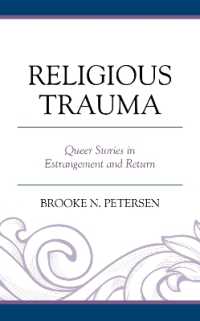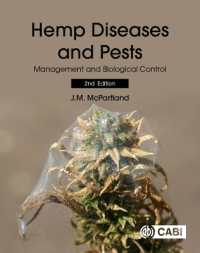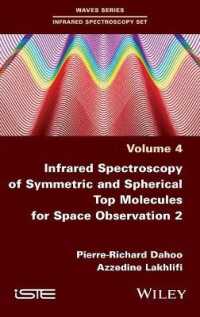- ホーム
- > 洋書
- > 英文書
- > Science / Mathematics
Full Description
Food Industry Wastesemerging techniques and opportunities for the treatment of food wastes, the reduction of water footprint, and creating sustainable food systems. Written by a team of experts from around the world, this book provides a guide for implementing bioprocessing techniques. It also helps researchers develop new options for the recuperation of these wastes for community benefit.More than 34 million tons of food waste was generated in the United States in 2009, at a cost of approximately $43 billion. And while less than three percent of that waste was recovered and recycled, there is growing interest and development in recovering and recycling food waste. These processes have the potential not only to reduce greenhouse gases, but to provide energy and resources for other purposes. This book examines these topics in detail, starting with sources, characterization and composition of food wastes, and development of green production strategies. The book then turns to treatment techniques such as solid-state fermentation and anaerobic digestion of solid food waste for biogas and fertilizer. A deep section on innovative biocatalysts and bioreactors follows, encompassing hydrogen generation and thermophilic aerobic bioprocessing technologies. Rounding out the volume are extensive sections on water footprints, including electricity generation from microbial fuel cells (MFCs), and life cycle assessments.
Contents
I. Introduction. Causes and Challenges of Food WastageII. Food Industry Wastes: Problems and OpportunitiesChapter 1. Recent European legislation for management of wastes in the food industryChapter 2. Sources, characterization and composition of the food wastesChapter 3. Development of green production strategiesIII. Treatment of Solid Food WastesChapter 4. Use of waste bread to produce fermentation productsChapter 5. Recovery of commodities from food waste using Solid-State FermentationChapter 6. Functional food and nutraceuticals derived from food industry wastes (FIW)Chapter 7. Manufacture of biogas and fertiliser from solid food wastes by means of anaerobic digestionIV. Improved Biocatalysts and Innovative Bioreactors for Enhanced Bioprocessing of Liquid Food WastesChapter 8. Use of immobilized biocatalyst for valorization of whey lactoseChapter 9. Hydrogen generation from food industry and biodiesel wastesChapter 10. Thermophilic aerobic bioprocessing technologies for FIW and wastewaterChapter 11. Modelling, monitoring and process control for intelligent bioprocessing of FIW and wastewaterV. Impact Assessment of Water Footprint and Rehabilitation of Food Industry WastewaterChapter 12. Water Footprint and food processing industry: accounting the impact of food waste from the perspective of use of water resourcesChapter 13. Electrical energy from wineries - A new approach using microbial fuel cells (MFCs)Chapter 14. Electricity generation from food industry wastewater using the MFC technologyVI. Assessment of Environmental Impact of Food Production and ConsumptionChapter 15. Life Cycle Assessment with the focus on FIWChapter 16. Food system sustainability and the consumerVII. Concluding Remarks and Future Prospects








